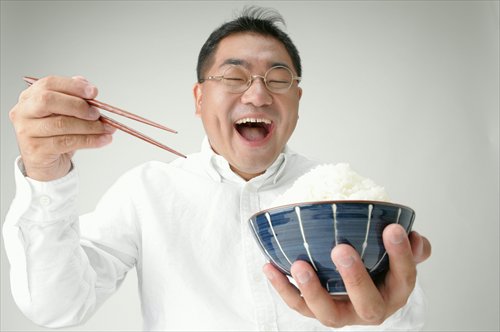Paying the price
Is expensive imported Japanese rice worth it?

Photo: IC
Following previous media reports about Chinese consumers snapping up Japanese toilet seats and rice cookers during this year's Spring Festival holidays, news articles claiming that some Chinese customers are buying Japanese rice at exorbitant prices have also grabbed attention.
Experts say domestically produced rice can be of the same high quality and is also cheaper, but less effective brand-building and quality concerns have undermined the position of domestic rice in the market.
A report on February 25 by domestic news portal people.com.cn cited a Taiwan newspaper as saying that some Chinese consumers are buying Japanese rice for as much as 300 yuan ($48.3) per kilogram. This compares to 5-10 yuan per kilogram for domestically produced rice, according to data from food industry portal http://www.21food.cn/.
The people.com.cn report also said the rising popularity of Japanese rice indicates a lack of confidence in the safety standards of Chinese rice.
The Shenzhen Special Zone Daily newspaper reported on Thursday that Japanese rice sells for 160-200 yuan per kilogram, citing a sales manager at a high-end supermarket in Shenzhen, South China's Guangdong Province.
The Japanese rice is usually imported in small quantities and it sells out soon after arriving, the manager said.
People who buy the high-priced Japanese rice appreciate its taste and the fact that pesticide is not used in its production, the Shenzhen-based newspaper reported.
However, experts said these media reports only refer to a small number of people, rather than the domestic market as a whole.
Not that different
"Most of the value in the so-called high-end Japanese rice is brand value. Affluent people are happy to pay the price and that's fine but ordinary citizens should not be tempted to follow suit," Ma Wenfeng, an analyst at Beijing Orient Agribusiness Consultant, told the Global Times Sunday.
"Chinese rice and Japanese rice is the same in terms of the nutrition they provide. The taste difference derives from a molecular structure difference in the starch," Ma noted.
"Rice is the staple food of the people. It is a daily necessity and should not be turned into a luxury item," said Gong Limin, a rice trader who operates the LOVE-FARM online shop on Alibaba's Tmall business-to-consumer marketplace.
Gong has contracts with rice producers who secure supplies from the city of Wuchang, center of a famed rice-producing region in Northeast China's Heilongjiang Province. Gong's shop relies on word of mouth for boosting sales and has won 2,000 customers since it opened in January.
"The rice produced in Wuchang is as good as the rice produced in Japan. Some produce from around a local reservoir even tastes better than Japanese rice," Gong told the Global Times Sunday.
Xing Xiao, a Chinese student who used to live in Japan, said the average rice sold in Japan is not that expensive. In 2013, the price was around 300 yen ($2.5) per kilogram, he said, even though better varieties can cost as much as 1,000 yen per kilogram.
"Is Japanese rice worth so much? I think, for some Chinese people, there is a distorted mentality to show off their wealth," Xing told the Global Times Sunday.
Customs data shows China imported 160 tons of Japanese rice in 2014, roughly triple the figure for 2013.
On January 28, a spokesman for the Ministry of Agriculture said the rise of Japanese rice imports was not because of reduced confidence in domestically produced rice, according to a post on the ministry's website.
The spokesman also said there was a high level of safety in Chinese rice production, adding that the Japanese imports only cater to some specific consumer groups in China.
China imported a total of 2.58 million tons of rice in 2014, or roughly 1.2 percent of the national consumption of 208.59 million tons in 2014.
Most of the imported rice was consumed by Japanese establishments in China, such as restaurants and Japanese companies, according to Ma.
The small import volume of the Japanese rice also contributes to the hefty prices, Ma noted, referring to the high logistics costs.
Confidence factor
The best Chinese rice, usually the organic type, also sells for higher-than-average prices, Gong said. For instance, a variety called Daohuaxiang No.2 sells for 30-50 yuan per kilogram in Shanghai.
"But there are still concerns over the quality of Chinese rice. Some people may blend old rice with new rice and sell it as new, which is detrimental for people's health. Other illegal practices include blending lower-quality rice with higher-quality rice," Gong said.
For instance, in 2010, the city of Wuchang had a registered annual production of 800,000 tons, but it actually sold 10 million tons of rice to traders nationwide by incorporating lower-quality rice from other regions, according to a CCTV report in July 2010.
Safety concerns have harmed people's confidence in domestically produced rice so there is no basis for raising prices, Gong said.
The Shenzhen Special Zone Daily said the exorbitant price of Japanese rice is a reminder to domestic rice traders of the importance of brand-building.
However, due to the thin margins in China's rice market, companies are reluctant to spend money on brand-building, the newspaper said, citing industry insiders.
Xing told the Global Times Sunday that Japanese rice traders attach great important to promotions such as cooking and tasting at supermarkets, as well as advertisements on television and in magazines. They also offer sponsorship for events such as rice-themed writing contests for pupils to nurture a new generation of brand-conscious consumers.
"But in Japan, where food safety standards are high and the market is fully competitive, you are more likely to accept the idea of 'the more you pay, the better the products you get,'" Xing said.
"Branching out into niche markets with diversified product offerings is one way to improve profitability for many Chinese agricultural companies," Ma said, noting that a supply glut in output, processing capacity, and storage of rice have weighed on rice prices for years.